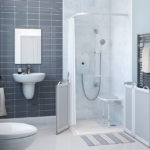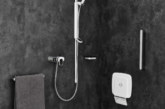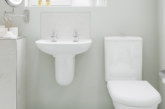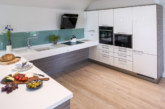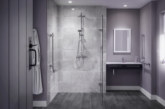Recent Department for Housing figures show that 119,621 disabled people or people with a medical condition were left waiting for an accessible home by their local authority in 2018/19, a rise of more than 10% since 2016/17. This is against the backdrop of only a 0.02% rise in the overall number of people on the social housing waiting list. The UK’s rapidly ageing population, increasing health challenges and the movement of older and disabled people from other tenures into social housing are all helping fuel this growth.
These latest figures have prompted the Housing Minister to commit to looking into whether the law needs to change, to ensure more new homes meet minimum accessibility standards. Although these changes will take time, Stuart Reynolds, Head of Product and Marketing at AKW, explains how social landlords can today bring good design to bear in cost-effective ways for those needing wheelchair accessible bathrooms.
Good wheelchair accessible bathroom design
What exactly constitutes ‘good’ wheelchair accessible bathroom design? Although any design needs to be tailored to the individual’s specific requirements, there are however common elements that should be included when specifying or installing any wheelchair accessible bathroom. The following is best practice advice taken from the Building Regulation’s Doc M[i] for wheelchair user dwellings and also from Kate Sheehan, Occupational Therapist of The OT Service for a well-designed wheelchair accessible bathroom:
Key characteristics of good design
Good design promotes safe movement and independence and also makes life better in the long-term for the wheelchair user in an accessible bathroom.
Promote movement around the space
Manoeuvring into and inside the bathroom are key considerations, not only when thinking about the wheelchair user but any personal care assistants that might accompany them. With this in mind:
- Prioritise level access throughout the space – use a wet room former, or a recessed or ramped shower tray
- Ensure doors are outward facing – this increases space in the bathroom and helps in case of emergencies
- Ensure easy and safe level shower access – this can be done by using a corner design for the shower space
- Minimise any gradient near the WC – a level access shower area has a gradient to help the water drain. Ensure that this is not part of the WC transfer zone, to minimise wheelchair tipping hazards
- Incorporate a raised height toilet – to allow for easier transfer from wheelchair to toilet seat
- Ensure toilet accessibility on both sides if possible – this is best-practice advice and facilitates transfers, personal assistant support and potential changes in need for the wheelchair user
- Ensure that there is no external plumbing and pipe work – to promote ease of movement around the space, all pipework needs to be concealed within the walls
- Think about the placement of radiators or towel rails –these can hinder wheelchair movement. Always opt for low surface temperature heat sources and consider underfloor heating as an alternative
- Use slip-resistant flooring – to maximise the traction of the wheelchair and minimise falls
- Use a wall hung sink – to improve access. Consider one with handles or a concave design to make things easier for a wheelchair user. The sink’s height should also be tailored to the user’s requirements (although compromises might be needed if the space is also used by the wider family).
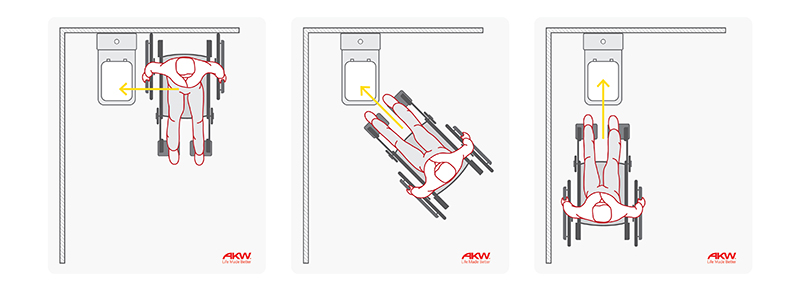
Good design promotes independence
The aim of any accessible bathroom is to promote the dignity of the user. If they are also able to use the space independently, then these are key elements to include:
- Think about shower placement – as this will impact movement around the space. For example, fittings can encroach up to 500mm on one side of the space (not both)
- Use technology to promote independence – for example AKW’s SmartCare Plus remote-controlled shower helps the wheelchair user control everything with no additional assistance
- Add a handle or rail to the door – to help the wheelchair user close the door behind them, without the need for additional assistance
- Tailor the placement of grab rails – to suit the abilities of the wheelchair user. Think about rail placement beside the WC, washbasin and level access shower. Depending on the bathroom’s layout, fold-up rails may benefit some users and any personal assistants
- Think about the user’s reach – to ensure that all of the essential fixtures and fittings (such as the toilet flush, light switches and bath/shower controls) are at a height and reach that supports functional use
- Incorporating a bidet – bidet’s promote user independence. If this is something that the wheelchair user would benefit from, remember to include an isolated electrical supply in compliance with Building Regulations for this.
Good design needn’t be expensive. In fact, the majority of the suggestions in AKW’s latest Wheelchair Accessible Bathroom Design guide are focused on using cost-effective adaptation equipment in ways that make sense to the space and to the wheelchair user.
For more details on how to ensure the best possible wheelchair accessible bathroom design, download the new Wheelchair Guide for Accessible Bathrooms at www.akw-ltd.co.uk

